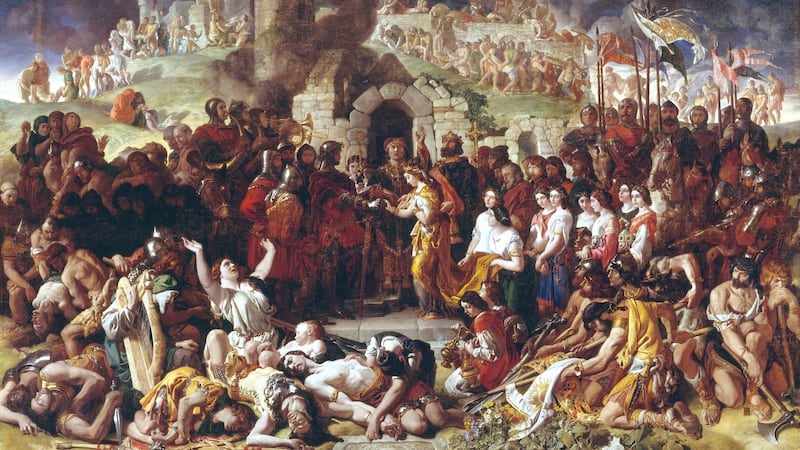What is it?
The Marriage of Strongbow and Aoife is a monumental history painting – more than 5m wide by 3m high – completed around 1854, by the Irish artist Daniel Maclise, who was born in 1806 and died in 1870. In it he imagines the marriage, in 1170 Waterford, of Aoife, daughter of King Dermot McMurrough of Leinster, and Strongbow, the Norman Richard de Clare.
How was it done?
We have Avengers: Infinity War. In the 1850s they had Maclise, his boundless imagination and a putative cast of hundreds, if not thousands. Maclise was enormously energetic, and he researched his subject scrupulously. He dramatises the historical shift represented by the marriage: McMurrough, under pressure, had enlisted the intervention of de Clare, pledging his daughter's hand and, on his demise, his title and lands, to the Norman. Nothing would ever be the same for the Irish. The stakes were high, but, still, Maclise ratchets up the drama shamelessly, laying on the symbolism, such as the shredded harp strings and Strongbow's foot resting on a Celtic cross. It's amazing to behold, but a bit heavy-handed.
Where can I see it?
A year ago Maclise's painting resumed its place of honour in the National Gallery of Ireland after an extensive conservation and research project funded by Bank of America Merrill Lynch's art conservation project. The work, which had appeared dull and dark and dusty, was transformed – as was the gallery. Strongbow's reappearance coincided with the reopening of the gallery after the most significant refurbishment and development programme since it first opened its doors, in 1864. If you have not had the opportunity to visit since then, make a point of doing so as soon as you can. The revamped complex is a revelation, showing off the collection as never before.

Is it a typical work by the artist?
For logistical reasons there are not many on this scale, but yes. Maclise was born in Cork, where his father was a soldier turned shoemaker. An imaginative child, Daniel knew from early on that he wanted to be an artist, but he was pressured into getting a job at a bank. The story goes that he did a quick portrait sketch of an illustrious visitor – Sir Walter Scott – which, a paparazzo of his time, he printed in lithographic form. The prints, plus additional duplicate sketches, earned him a substantial sum.
Emboldened, he departed for London and repeated the tactic there, earning enough to finance his studies at the Royal Academy Schools. (He became an academician in time and later in life turned down an invitation to become its president.) Charles Dickens numbered among his portrait subjects, although he increasingly invested his energies in big subject paintings involving numerous figures, drawing on episodes from history and literature. He did not want for commissions, and completed other paintings on the scale of The Marriage of Strongbow and Aoife; his epic subjects include the death of Lord Nelson and the meeting of Wellington and the Prussian field marshal Gebhard Leberecht von Blücher, the veteran commander whose army is generally regarded as turning the tide at Waterloo.
But such projects were not dissimilar from taking on Hollywood productions, involving a staggering amount of work, disproportionately bearing on the shoulders of just one individual rather than a vast film crew. He was, if you like, writer, director, producer and crew all in one. And he was very conscientious. The raft of demands, including sheer labour and petty squabbling over details and finances, wore him down physically and emotionally. He became disenchanted and, in 1870, succumbed to pneumonia.












